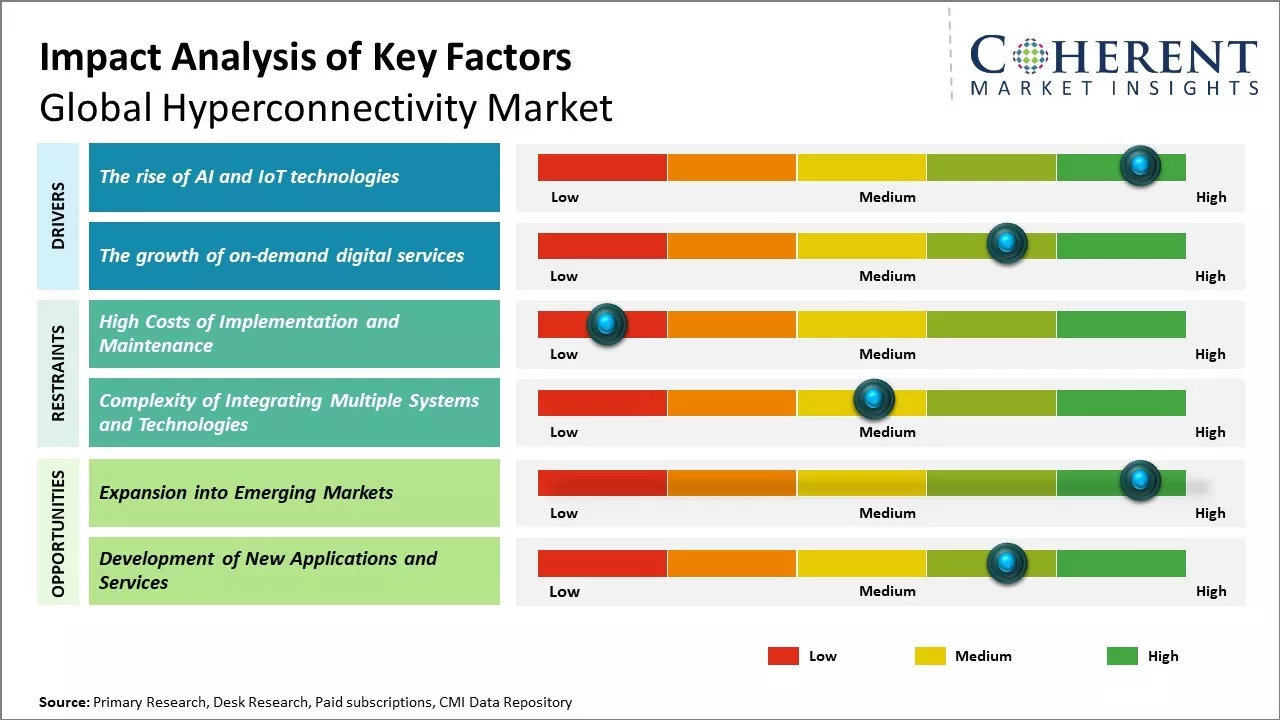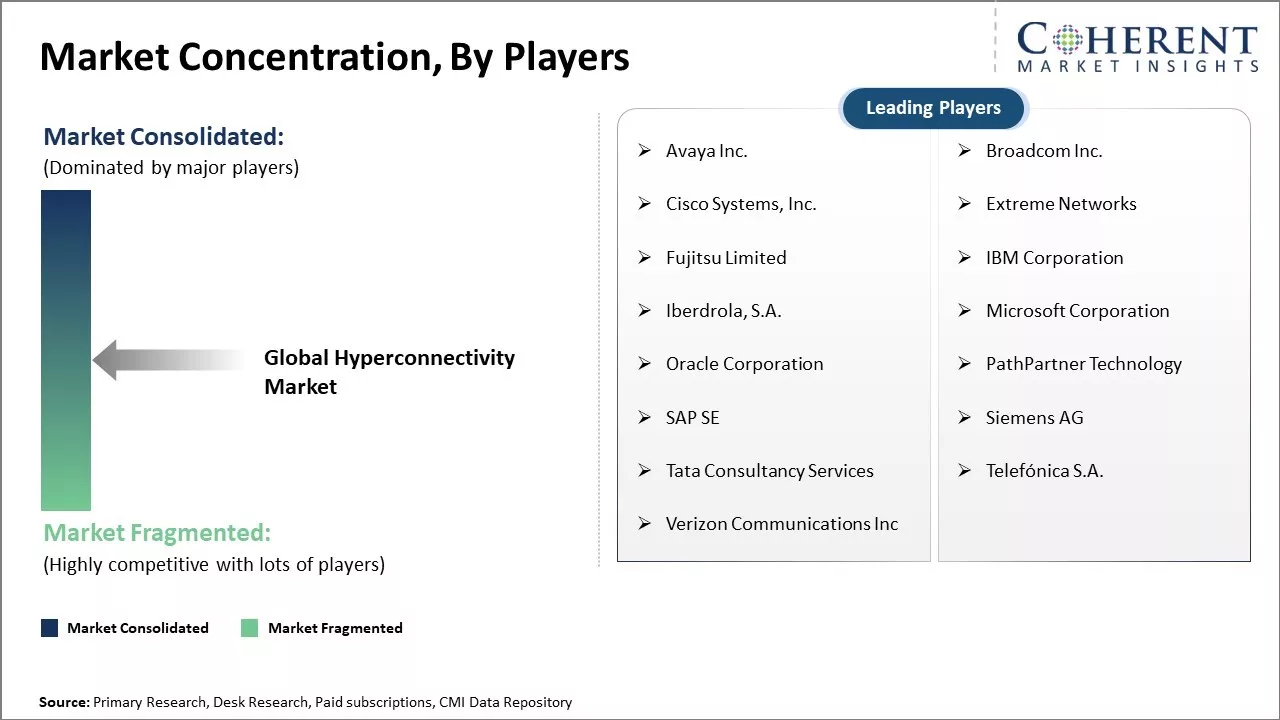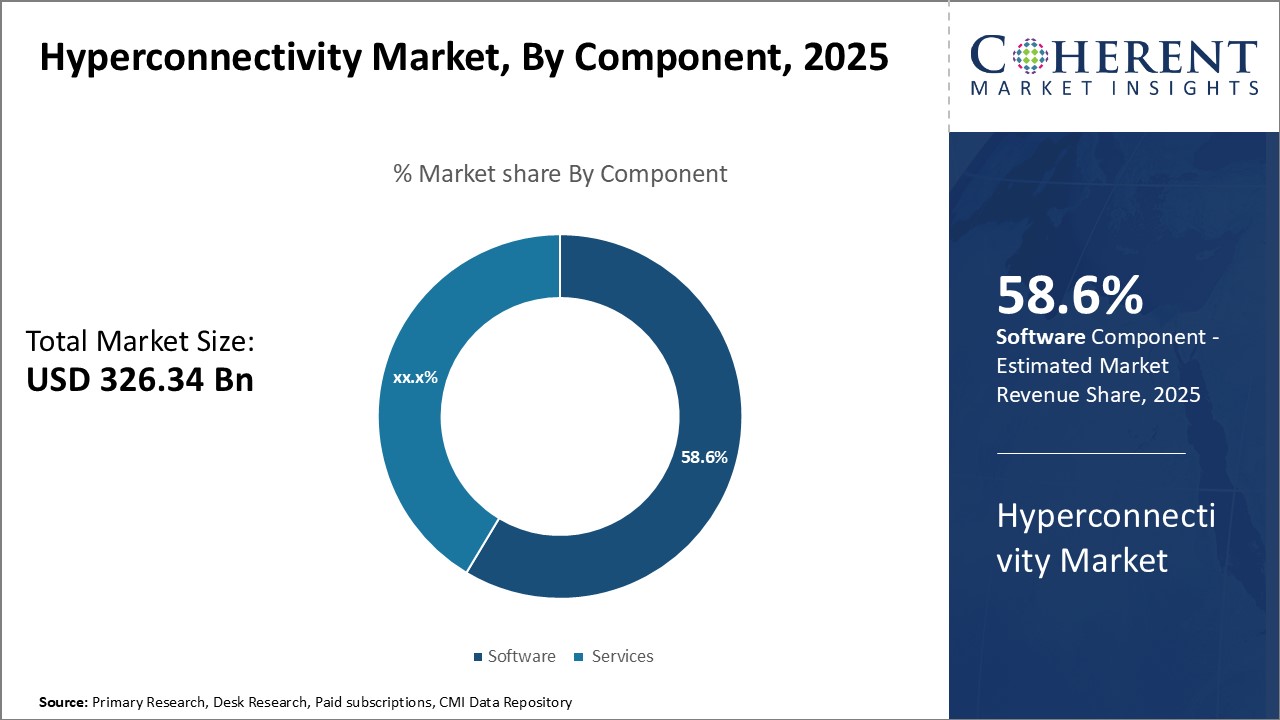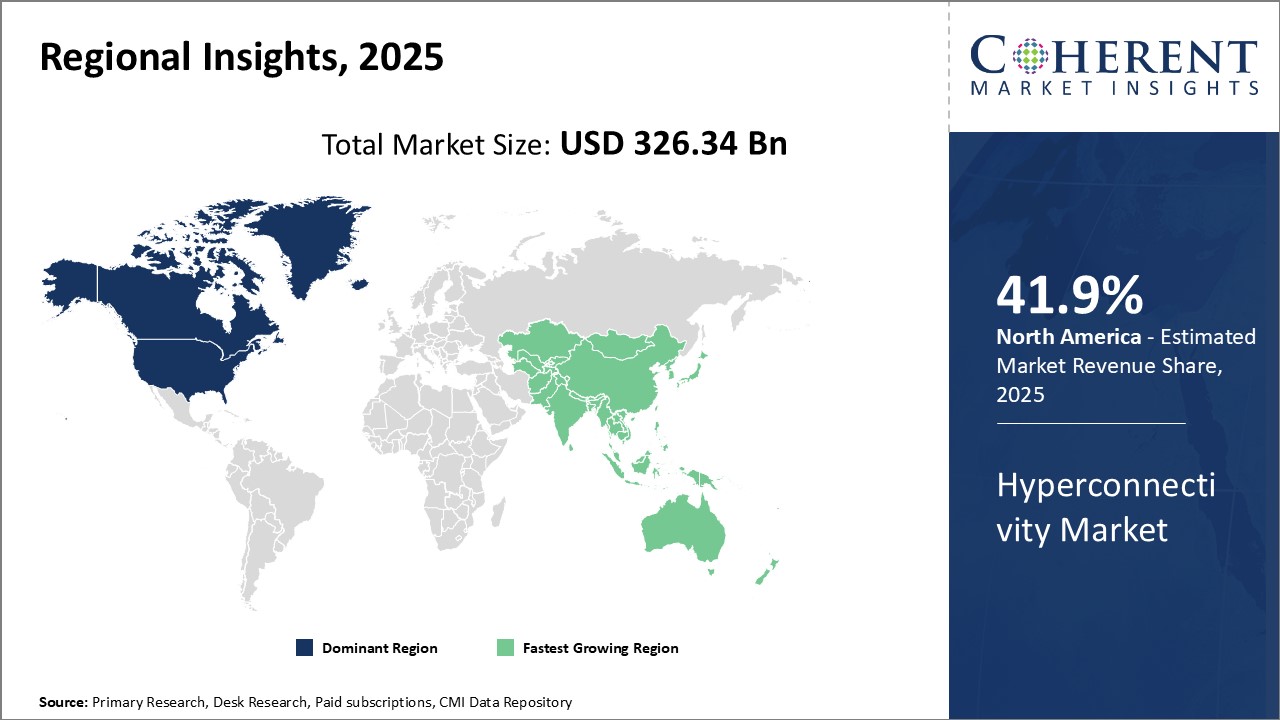Hyperconnectivity Market Size and Trends
Global hyperconnectivity market is estimated to be valued at US$ 326.34 Billion in 2025 and is expected to reach US$ 1,218.63 Billion by 2032, exhibiting a compound annual growth rate (CAGR) of 20.7% from 2025 to 2032.

Discover market dynamics shaping the industry: Download Free Sample
Global hyperconnectivity market growth is driven by rising adoption of technologies such as 5G, cloud computing and IoT across industries. Increasing internet penetration worldwide also boosts need for faster connectivity. Furthermore, growing demand for seamless customer experience prompt organizations to invest in platforms that enable hyperconnectivity. Edge computing is emerging as an important enabler of low latency connectivity and can drive the market growth. Significant technological advancements such as wide-scale 5G deployment can expand the potential use cases for hyperconnectivity. Various industries are exploring innovative applications of hyperconnected systems to improve operational efficiency and service delivery.
Rise of AI and IoT technologies
As we move towards a more connected world, artificial intelligence and internet of things technologies have become integral drivers of hyperconnectivity. Advanced technologies enable greater intelligence, automation and data exchange capabilities across almost every industry and sector. Cutting edge AI functionalities such as machine learning, predictive analytics and autonomous decision making are being embedded into various systems, machines, devices and platforms. This allows for highly advanced levels of interactivity, coordination and optimization both between humans and technologies as well as between different technologies themselves.
The proliferation of IoT devices from smartphones and wearables to industrial equipment and connected vehicles can generate massive amounts of data on a continuous basis. These devices are becoming increasingly "smarter" with enhanced sensing, processing and communication features. As more and more "things" get connected to each other as well as to centralized systems in the cloud, it is unleashing new possibilities for data driven insights and optimizations. Organizations across industries are leveraging AI and IoT synergies to develop innovative use cases around predictive maintenance, autonomous operations, customized experiences, environmental monitoring and more. This boosts the need for hyperconnected infrastructure that can support ultra-low latency interactions, massive networked bandwidth and extremely high density of simultaneous connections.
Market Concentration and Competitive Landscape

Get actionable strategies to beat competition: Download Free Sample
Growth of on-demand digital services
With the rise of sharing economy models and the dominance of smartphone based digital lifestyles, people's expectations from services have changed dramatically in recent years. There is now an immense appetite for services that can be accessed on-demand through mobile and web platforms, without any physical hassles. On-demand services has gained popularity in transportation, food delivery, shared workspaces, logistics or media streaming. While meeting customer demand for convenience and flexibility, such digital services have also led to highly complex operational requirements. Fulfilling millions of fragmented and location-specific service requests in real-time requires agile, cost-effective and exponentially scalable connectivity solutions.
On the supplier side, providing consistently excellent on-demand user experiences has become a competitive necessity. It demands sophisticated backend networking abilities to seamlessly integrate dispersed physical/digital assets as well as coordinate large pools of mobile workers. Even minor issues with network latency, bandwidth constraints or device/server uptime can negatively impact customer satisfaction and business revenues. This underscores the crucial role of hyperconnectivity in powering the intricate, time-sensitive orchestration needs of on-demand digital services at massive global scales. As such services continue deepening their penetration, major technological and infrastructural enhancements will drive the market growth.
Key Takeaways from Analyst:
Global hyperconnectivity market growth is driven by growing internet penetration around the world. As more devices get connected to the internet, there will be increase in amount of data being generated and shared. This rapid growth in data traffic boosts the need for higher speed connectivity technologies that can support exponentially higher data consumption. Advanced technologies like 5G networks and AI/ML also play a crucial role in enabling hyperconnected environments of the future.
North America currently dominates the hyperconnectivity market, owing to heavy investments by tech giants in the region to develop smart infrastructure. However, Asia Pacific is expected to be the fastest growing regional market with China and India likely to contribute to the market growth. This can be attributed to huge internet user base and government initiatives to create smart cities in these developing economies. Security concerns around hyperconnected devices and networks can pose serious challenges. Lack of common connectivity standards is another area that needs attention from policymakers and industry.
Collaboration between technology providers, telecom operators and enterprises will be important to fully maximize the benefits of hyperconnectivity. Hyperconnectivity market can witness growth as digital transformation gathers pace across industries. While developed markets will continue leading, developing regions offer huge untapped potential for future business opportunities.
Market Challenges: High Costs of Implementation and Maintenance
The high costs associated with implementation and maintenance h can hamper the growth of the hyperconnectivity market. Setting up the advanced communication networks and infrastructure required to enable hyperconnectivity across organizations and systems can be expensive. It involves laying fiber optic cables, installing numerous cell towers and base stations for 5G networks, upgrading existing wireless and wired networks to support higher bandwidths and lower latencies, and others. Moreover, maintaining such advanced networks becomes a perpetual expense. Technology is constantly evolving at a rapid pace in the connectivity sector. To keep the networks up to date, organizations need to continuously invest in upgrading switches, routers, servers and other network hardware. These also need to hire networks engineers and technicians to monitor networks performance on a 24/7 basis and address any issues that may crop up. The operating costs associated with powering such large networks and their cyber-security also significantly add to the maintenance expenditures.
Market Opportunities: Expansion into Emerging Markets
Expansion into emerging markets can offer tremendous opportunity for growth of hyperconnectivity market. Hyperconnectivity refers to the ever-growing connections between people, organizations, sensors and devices enabled by next-generation technologies. Emerging economies are witnessing massive digital transformation as access to high-speed internet and smartphones is becoming widely available.
Countries in South America, Asia and Africa that were previously unconnected are now being brought online. This represents a huge untapped consumer base that is hungry for engagement through social media, entertainment, education and commerce applications. As smartphone prices decline significantly and local telecom infrastructure builds out nationwide 4G and 5G networks, many new users are projected to come online in the near future. This rapid rise in internet and device connectivity will boost demand for hyperconnected experiences across society.
Local businesses in emerging markets also recognize that digital transformation and innovative connectivity solutions are crucial for reaching customers, participating in global trade and boosting competitiveness. Industries like manufacturing, agriculture, healthcare and education increasingly rely on real-time data exchange between remote devices, assets and personnel for improved efficiency and outcomes. Governments are making major investments in digital public services, e-governance platforms and smart city initiatives to foster development and economic growth. This presents a massive commercial opportunity for hyperconnectivity vendors to establish early market leadership by tailoring offerings that meet the unique needs of these developing societies and industries.

Discover high revenue pocket segments and roadmap to it: Download Free Sample
Insights By Component- Software segment at the core of hyperconnectivity
In terms of component, software segment is expected to contribute the highest market share of 58.6% in 2025, owing to its central role in enabling hyperconnectivity. Sophisticated software solutions are key to integrating disparate systems, devices, and data sources across organizations and providing seamless interoperability in real time. As businesses adopt Internet of Things technologies and seek to leverage cross-device data insights, there is huge demand for user-friendly, scalable software platforms that can orchestrate communication and data flow between an expanding networks of connected endpoints. Leading technology vendors have invested heavily in developing advanced hyperconnectivity software equipped with machine learning and artificial intelligence capabilities to autonomously manage complex frameworks of interrelated systems. Customizable cloud-based offerings allow companies from diverse industries to efficiently establish hyperconnected environments tailored to their unique operational needs and workflows. With software driving the underlying connectivity fabric across the modern digital landscape, its importance will continue augmenting as hyperconnectivity becomes integral to digital transformation strategies.
Insights By Product Type - Cloud at the center of hyperconnectivity
In terms of product type, cloud platforms segment is expected to contribute the highest market share of 40.8% in 2025, owing to the strategic advantages it provides in enabling hyperconnectivity. Transitioning infrastructure and applications to the cloud allows organizations to extract maximum value from hyperconnectivity by facilitating seamless data access and exchange between decentralized user networks. Sophisticated cloud platforms leverage application programming interfaces and distributed edge computing to integrate disparate on-premise and remote systems through a unified interface. This boosts the need for expensive hardware infrastructure upgrades and delivers intrinsic scalability to support hypergrowth. The cloud's standardized, on-demand provisioning model uniquely positions it to orchestrate extensive webs of interdependent technologies and unleash hyperconnectivity's full potential. As 5G proliferates and more mission-critical functionalities shift online, dependency on robust cloud services for driving expansive interconnectivity across dynamic digital ecosystems will deepen considerably.
Insights By End-use Industry - Connected technologies transform industries
In terms of end-use industry, IT & telecommunications segment is expected to contribute the highest market share of 37.3% in 2025, as hyperconnectivity is integral to its advanced services and business models. Communication service providers are utilizing hyperconnected infrastructures to pioneer immersive digital experiences through 5G, Internet of Things, and smart city solutions. Hyperconnectivity also allows telecom companies to streamline operations, enhance quality of service through predictive maintenance of networks, and proactively service client needs based on real-time usage insights. Hyperconnected supply chains powered by autonomous logistics are streamlining inventory and fulfillment processes across manufacturing. As digital transformation progresses globally, every industry leverage insights synthesized across hyperconnected systems and surfaces to gain competitive advantages, optimize resources, and deliver enhanced customer satisfaction.
Regional Insights

Need a Different Region or Segment? Download Free Sample
North America dominates the global hyperconnectivity market with an estimated market share of 41.9% in 2025. With presence of tech giants like Google, Microsoft and major telecom players such as AT&T and Verizon, the region is at the forefront of innovation and 5G technology adoption. The strong telecommunication infrastructure, along with high smartphone and internet penetration have allowed companies to exploit hyperconnectivity opportunities.
North America is a hub for startups working on Internet of Things (IoT), artificial intelligence and sensors that boosts demand for hyperconnectivity. Established companies are actively collaborating or acquiring these startups to be ahead in the technology curve. The large corporate customer base is also substantially investing in technologies that require hyperconnected environments for efficient operations. The North American governments are also supportive with conducive policies for deploying 5G networks nationwide in the coming years.
Asia Pacific is emerging as the fastest growing region in the global hyperconnectivity market. Countries like Singapore, Malaysia, Indonesia, Thailand and Vietnam are aggressively investing in digital transformation projects. The governments are focusing on robust connectivity infrastructure to bolster their respective 'Smart nation' initiatives. This makes South East Asia a lucrative market for telecom vendors and technology providers.
Strong economic growth across the region has increased discretionary spending on smart devices and technologies. Local conglomerates are also investing heavily to develop homegrown IoT and AI solutions. International manufacturers are evaluating South East Asia for hyperconnected factories of the future with 5G capabilities. The improving connectivity landscape will attract more investments and partnerships in the region for hyperconnectivity dependent applications in the future.
Market Report Scope
Hyperconnectivity Market Report Coverage
| Report Coverage | Details | ||
|---|---|---|---|
| Base Year: | 2024 | Market Size in 2025: | USD 326.34 Bn |
| Historical Data for: | 2020 To 2024 | Forecast Period: | 2025 To 2032 |
| Forecast Period 2025 to 2032 CAGR: | 20.7% | 2032 Value Projection: | USD 1,218.63 Bn |
| Geographies covered: |
|
||
| Segments covered: |
|
||
| Companies covered: |
Avaya Inc., Broadcom Inc., Cisco Systems, Inc., Extreme Networks, Fujitsu Limited, IBM Corporation, Iberdrola, S.A., Microsoft Corporation, Oracle Corporation, PathPartner Technology, SAP SE, Siemens AG, Tata Consultancy Services, Telefónica S.A., and Verizon Communications Inc |
||
| Growth Drivers: |
|
||
| Restraints & Challenges: |
|
||
Uncover macros and micros vetted on 75+ parameters: Get instant access to report
Hyperconnectivity Industry News
- In October 2022, Uniphore, a pioneer in conversational AI and automation, announced a strategic partnership with Avaya, a global leader in solutions to enhance and simplify communications and collaboration, to bring Uniphore's integrated Conversational AI and communications platform to customers across the Middle East and Africa (MEA) region. This partnership aims to provide unparalleled, frictionless customer experiences to MEA customers by integrating Uniphore's Conversational AI and Automation products with the Avaya OneCloud CCaaS platform.
- In June 2022, Kyndryl, the world's largest IT infrastructure services provider that was spun off from IBM in 2021, announced a partnership with Oracle to help customers accelerate their journey to the cloud. Through this partnership, Kyndryl and Oracle will deliver managed cloud solutions to enterprises globally, enabling them to modernize their IT infrastructure and unlock the full potential of cloud computing.
- In May 2022, Avaya, a leading provider of communication solutions that enhance and simplify customer engagement, expanded its global partnership with Microsoft Corp., a major player in cloud computing and software solutions. This partnership combines the Avaya OneCloud portfolio with Microsoft Azure, providing organizations with enhanced options to boost productivity and customer engagement while ensuring unrivaled reliability, agility, and scalability.
- In July 2020, Verizon Business, a leading telecommunications company, announced a collaboration with IBM, a global leader in technology and consulting services, to drive innovation in 5G and edge computing aimed at enabling the future of Industry 4.0. The partnership will combine Verizon’s high-speed, low-latency 5G and Multi-access Edge Compute (MEC) capabilities, alongside IoT devices and sensors, with IBM’s expertise in AI, hybrid multicloud solutions, edge computing, asset management, and connected operations. Together, these aim to enhance industrial operations and facilitate the adoption of advanced technologies across various sectors.
*Definition: Global Hyperconnectivity Market involves technologies and solutions that enable the seamless connection of billions of devices across the world instantly and securely. It allows machines, people, and objects to connect and interact with each other in real-time through advanced communication networks. This hyperconnected infrastructure drives emerging technologies like IoT, AI, robotics, autonomous vehicles, and more to deliver optimized connectivity experiences to consumers and businesses on a global scale.
Market Segmentation
- Component Insights (Revenue, US$ Bn, 2020 - 2032)
- Software
- Services
- Product Type Insights (Revenue, US$ Bn, 2020 - 2032)
- Enterprise Wearable Devices
- Middleware Software
- Cloud Platforms
- Business Solutions
- End-use Industry Insights (Revenue, US$ Bn, 2020 - 2032)
- BFSI
- Healthcare & Life Sciences
- IT & Telecommunications
- Government
- Manufacturing
- Retail & E-commerce
- Media & Entertainment
- Others
- Regional Insights (Revenue, US$ Bn, 2020 - 2032)
- North America
- U.S.
- Canada
- Latin America
- Brazil
- Argentina
- Mexico
- Rest of Latin America
- Europe
- Germany
- U.K.
- Spain
- France
- Italy
- Russia
- Rest of Europe
- Asia Pacific
- China
- India
- Japan
- Australia
- South Korea
- ASEAN
- Rest of Asia Pacific
- Middle East & Africa
- GCC Countries
- Israel
- South Africa
- Rest of Middle East & Africa
- North America
- Key Players Insights
- Avaya Inc.
- Broadcom Inc.
- Cisco Systems, Inc.
- Extreme Networks
- Fujitsu Limited
- IBM Corporation
- Iberdrola, S.A.
- Microsoft Corporation
- Oracle Corporation
- PathPartner Technology
- SAP SE
- Siemens AG
- Tata Consultancy Services
- Telefónica S.A.
- Verizon Communications Inc
Share
Share
About Author
Monica Shevgan has 9+ years of experience in market research and business consulting driving client-centric product delivery of the Information and Communication Technology (ICT) team, enhancing client experiences, and shaping business strategy for optimal outcomes. Passionate about client success.
Missing comfort of reading report in your local language? Find your preferred language :
Transform your Strategy with Exclusive Trending Reports :
Frequently Asked Questions
EXISTING CLIENTELE
Joining thousands of companies around the world committed to making the Excellent Business Solutions.
View All Our Clients
